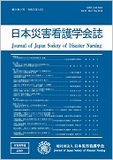Japanese
English
- 有料閲覧
- Abstract 文献概要
- 参考文献 Reference
要旨
【目的】本研究の目的は、災害急性期から亜急性期における高齢者のニードに関する支援看護師の認識を明らかにすることである。
【方法】災害急性期から亜急性期の活動経験を有する看護師5名に半構成的面接を行い、質的に分析した。
【結果】支援看護師が高齢者のニードを捉えた環境は、【短期間で替わる外部支援者への気遣いと被災者同士の強い結束】などの4のカテゴリーに集約された。また、高齢者のニードは、【避難所に留まる高齢者の心身の停滞】などの6のカテゴリーに集約された。さらに、高齢者のニードに対する支援看護師の看護は、【営みを妨げないよう関心を示し、高齢者の気がかりや困りごとを聴いて変化を察知】などの3のカテゴリーに集約された。
【結論】支援看護師は、高齢者の身体機能面と周囲の環境との相互作用から高齢者のニードを捉えていた。また、高齢者に関心を示し、話を聴きに行くという能動的な行動で高齢者の心身に関するニードを捉え、被災者の営みを妨げないように手助けするという支持的な姿勢で高齢者の相互扶助を支える看護を実践していた。
Objective
The purpose of this study is to clarify the disaster response nurse's recognition of the needs of elderly people during the acute to subacute phases of a disa ster.
Method
We conducted a semi-structured interview with five disaster response nurses and performed qualitative analysis of the obtained data.
Result
The environment in which the nurses realized elderly people's needs was consolidated into four core categories, such as “Concern about external supporters who change around in a short period, and a strong unity between victims.” The elderly people's needs were consolidated into six categories, such as “Mental and physical stagnation of elderly people staying in an evacuation center.” Nursing to meet elderly people's needs was consolidated into three categories, such as “Show interest in elderly people without disturbing their activities and listen to their concerns and troubles to be aware of changes in them.”
Conclusion
The disaster response nurses became aware of the elderly people's needs due to the interaction between the physical function and the surrounding environment. In addition, they realized the elderly people's needs of mind and body with active actions of showing interest and going to listen to their stories, and they practiced nursing with a supportive attitude to prevent disturbance of their activities.
Copyright © 2019, Japan Society of Disaster Nursing All rights reserved.


